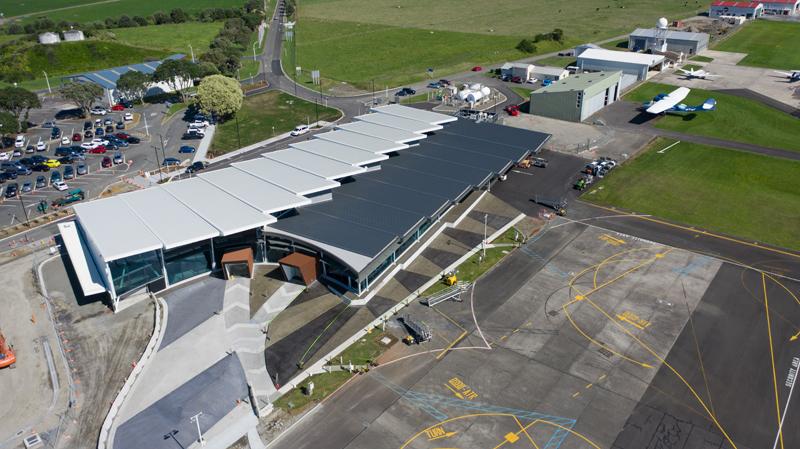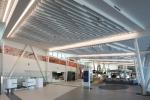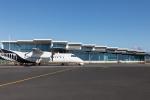Local legend embedded in design of New Plymouth’s airport terminal

Some key design principles were established by a collective Beca design team, liaising with the local hapu to ensure the iwi’s story and history was reflected in the New Plymouth Airport terminal. Located 11km from the city centre, the building is located on a historic coastal site where Puketapu Hapu has been based for centuries until the land was taken under the Public Works Act in the 1960s.
The project’s genesis began back in 2013 when altering an existing terminal, built in the 1960’s, was under consideration but 2016 marked a turning point when a workshop was held that included Puketapu and a current brief was established for a modern, regional gateway to Taranaki to be developed.
The new $28.7 million facility reflects a distinctive cultural narrative to match other contemporary structures in the region – notably the iconic Len Lye Centre with its curtain-like stainless steel façade or the Te Rewa Rewa bridge at Fitzroy with its wave-like composition. The new terminal is a welcome addition to an unmatched little corner of Aotearoa, embracing the area’s rich history.
“New Plymouth Airport presented an exciting opportunity to co-design with Puketapu Hapu to create an iconic asset that was uniquely and distinctly Taranaki”, says Beca’s project lead architect, Campbell Craig.
“The partnership between the iwi designers and architects and the willing investment and sense of ownership from all involved exceeded expectations. The collaborative design process required hard work, dedication and all-day workshops without hierarchy or boundaries. Matthew Low from Beca who has done an enormous amount of work on this project was the Project Manager for the overall project.”
The design team considered all the functional requirements of the building and how it would adapt to the future needs of travellers. From a capacity of 50,000 passengers per year the new airport is designed to now cater for 450,000 per year with provision for expansion to happen when numbers rise.
Project Director for the New Plymouth Airport Redevelopment, Gaye Batty says from the outset it was important the building incorporated a sense of welcoming with curves at the passenger departure and arrival gates, symbolising the embrace of passengers and visitors. The roof form became integrated into the fabric and structure of the building, stepping around these curves with a design reflecting the Te Atiawa legend of a whatu kura, or celestial being called Tamarau-te-heketanga-a-rangi who as legend would have it, came down from the heavens when he saw a woman called Rongoueroa bathing in the local Waiongana river.
This theme of the sky meeting the earth is central to Beca’s creation for a sweeping high-low dual roof structure where one side appears to descend from a landscaped earth mound while the other sweeps down from the heavens from where the planes and passengers descend.
The hapu legend was the perfect story to be implemented in how the design team approached the design – people arriving at a welcoming, physical meeting point.
Many hours were spent deliberating over the roof and how it was paramount that no penetrations could go through it. Together with Beca Services engineers this was achieved by placing all service terminations into four purpose-built service rooms located at the junction between the higher and lower roofs. All these rooms had floor to ceiling louvres allowing all the services to terminate in these rooms.
The proximity to the coast and strong winds meant certainty was required that a clip fix system would work in this location. Independent reports were undertaken to ensure the roof would withstand the forces present and Metalcraft’s Metdek855 system in 0.9mm aluminium was able to achieve this. Metalcrafts Metdek 855 dedicated rollformer rolled the 40m sheets onsite as the sheets were too long for road transportation.
The two roofs, made up of sheets up to 40m in length provided 285mm wide pans giving a strong pattern of clean lines for an important 5th elevation of the building when viewed from planes flying above, the 4,600m2 roof eventually having only one small 100mm terminal vent penetrating the roof with no mechanical fixings present.
The two legendary entities – The Lifting of the Earth and Descending of the sky - are expressed in the two roof forms. One roof form appears to step up from the landscaped mound (Rongo-ue-roa) to meet the second descending roof form (Tamarau), their symbolic and literal joining materialised along the full length of the public concourse by the intersection (Te Hiringa). The chevron Kaokao is subtly cut into the acoustic blade ceiling, linear lighting, floor tiles, custom Decortech panels and three pairs of tawa pillars running down into the centre providing form and function to support the roof. These columns are laminated and cigar-shaped.
The terminal has been designed with a layout to create welcoming “wayfinding” outcomes. Passengers can easily see the next destination in their terminal journey with the open plan layout to create calm and ease throughout their time in the terminal. Congestion points were a hot topic – a fine balance between pinch points on the public spaces against over-compensating and having a space that was too large.
Mt Taranaki is seen from inside the terminal satisfying the visual connection of the brief: the location, orientation and alignment of the public concourse and the overall terminal is informed by the original foot track leading from the mountain to the mouth of the nearby Waiongana river – so passengers enter and walk down the concourse – walking the same path as Te Atiawa ancestors walked many years before.
Close attention was given to paint systems, neutral colours chosen for the walls and ceiling and these were reviewed very thoroughly during construction. Much consideration was given to the building orientation to maximise passive solar gain and reduce energy loss. Enhanced building fabric elements such as insulation, low-e glass and an internal living wall increased indoor air quality and energy and water metering along with various technological innovations with the HVAC systems and lighting fixtures and BMS controls were incorporated resulting in lower energy costs.
The faceted glazing is designed as an acoustic barrier from aircraft noise and limits thermal heat transfer as an energy saving feature: the glass is tinted blue airside and a slightly browner tone landside. The wide eaves also shelter the building from direct penetrating sunlight.
“The result is an absolutely clean roof line which will have a very high resistance to the elements”, says Gaye Batty.
Campbell said a project charter was established for the main parties to the contract (Embracing our past – Building our future) involving main contractor Clelands Construction, Puketapu Hapu, New Plymouth Airport, Beca and Rider Levett Bucknall providing a single vision for the way everybody would work together on this project.
“Clelands Construction were excellent to work with and the quality of work and good communication between the key parties to the contract continued for the duration of the project.”
“This building is like no other and could not be meaningfully placed anywhere else in the world. It is iconic in form with two intersecting stepping volumes and faceted curved glazing. It is unique in its storytelling and exclusive contemporary toi tangata. It is distinctly Taranaki, rich in aesthetic, storytelling, meaning, cultural heritage and collaboration.”
Beca designed the New Plymouth airport terminal as a collective team of many and this team approach has contributed to the success of the project. In some cases, someone needed to ‘make the call’ when discussion had gone around in circles for too long, but for the most part the team worked well together and aligned to the vision presented to them.
ARCHITECT
Beca has just celebrated its 100-year anniversary, with the architecture section of the business being over 35 years old. Twenty-five team members are spread across Auckland, Tauranga and Christchurch. The practice works across a wide range of market typologies including commercial, retail, industrial, process, education, health, tourism, civic and infrastructure. Beca takes pride in the buildings and spaces it helps to create and the numerous industry design awards are recognition that those results achieve not only what the client is looking to achieve but Beca’s successful integration of the build form into the environment with care and consideration.



